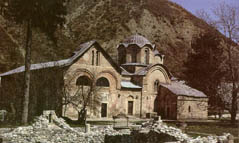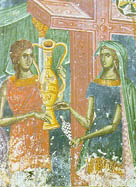PEC
 Two
kilometers from Pec, at the entrance to the Rugovo gorge, stands the Patriarchate
of Pec. The monastery church is really a complex of four churches built
side by side and three of them are now integrated into a single structure.
The oldest, the Church of the Holy Apostles, was built in the mid- 13th
century by Serbia's second archbishop, Arsenije. As soon as the construction
was completed, Arsenije ordered the seat of the archbishopric to be transferred
there from Zica. Early in the 14th century, with about 10 years
between the construction of each, new churches were built on either side
of the one already existing - the Church of St. Demetrius to the north,
and the Church of the Virgin with the small Church of St. Nicholas to the
south. Finally, a narthex was built on the western side joining together
all three of the larger churches.
Two
kilometers from Pec, at the entrance to the Rugovo gorge, stands the Patriarchate
of Pec. The monastery church is really a complex of four churches built
side by side and three of them are now integrated into a single structure.
The oldest, the Church of the Holy Apostles, was built in the mid- 13th
century by Serbia's second archbishop, Arsenije. As soon as the construction
was completed, Arsenije ordered the seat of the archbishopric to be transferred
there from Zica. Early in the 14th century, with about 10 years
between the construction of each, new churches were built on either side
of the one already existing - the Church of St. Demetrius to the north,
and the Church of the Virgin with the small Church of St. Nicholas to the
south. Finally, a narthex was built on the western side joining together
all three of the larger churches.
 The
frescoes in these churches belong to various periods. The oldest, in the
sub-dome of the Church of the Holy Apostles, date fback to the time of its
construction, the first half of the 13th century. In forceful
expression, general concept and size, they belong to the 13th
century monumental painting with its clearly defined features (Studenica,
Mileseva, Sopocani). In the dome, the apostles, angels and the Assumption
of the Virgin are very impressive. The paintings in the front of the church
are from the 14th century, and closely related to the frescoes
in the Church of St. Clemence in Ohrid. A small portion of the frescoes
in this part of the church belong to the 17th century.
The
frescoes in these churches belong to various periods. The oldest, in the
sub-dome of the Church of the Holy Apostles, date fback to the time of its
construction, the first half of the 13th century. In forceful
expression, general concept and size, they belong to the 13th
century monumental painting with its clearly defined features (Studenica,
Mileseva, Sopocani). In the dome, the apostles, angels and the Assumption
of the Virgin are very impressive. The paintings in the front of the church
are from the 14th century, and closely related to the frescoes
in the Church of St. Clemence in Ohrid. A small portion of the frescoes
in this part of the church belong to the 17th century.
Most of the frescoes in the Church of St. Demetrius were painted by the
master painter Jovan, who left his signature, in Greek, in the altar area
where it can still be seen. These works differ considerably from those of
the 13th century and those of the Milutin period. Particularly
characteristic is the artist's evident devotion to detail. The Handmaid
with the Jug, a detail in The Birth of the Virgin of the altar apse, has
become well-known in the art world for the figure's charm and its classical
beauty.
The monastery treasury housed in the Church of St. Demetrius, includes
a number of icons, volumes in manuscript and gold and silver items. The
icons were made in the Pec workshop, which was particularly active in the
second half of the 16th century.


 Two
kilometers from Pec, at the entrance to the Rugovo gorge, stands the Patriarchate
of Pec. The monastery church is really a complex of four churches built
side by side and three of them are now integrated into a single structure.
The oldest, the Church of the Holy Apostles, was built in the mid- 13th
century by Serbia's second archbishop, Arsenije. As soon as the construction
was completed, Arsenije ordered the seat of the archbishopric to be transferred
there from Zica. Early in the 14th century, with about 10 years
between the construction of each, new churches were built on either side
of the one already existing - the Church of St. Demetrius to the north,
and the Church of the Virgin with the small Church of St. Nicholas to the
south. Finally, a narthex was built on the western side joining together
all three of the larger churches.
Two
kilometers from Pec, at the entrance to the Rugovo gorge, stands the Patriarchate
of Pec. The monastery church is really a complex of four churches built
side by side and three of them are now integrated into a single structure.
The oldest, the Church of the Holy Apostles, was built in the mid- 13th
century by Serbia's second archbishop, Arsenije. As soon as the construction
was completed, Arsenije ordered the seat of the archbishopric to be transferred
there from Zica. Early in the 14th century, with about 10 years
between the construction of each, new churches were built on either side
of the one already existing - the Church of St. Demetrius to the north,
and the Church of the Virgin with the small Church of St. Nicholas to the
south. Finally, a narthex was built on the western side joining together
all three of the larger churches. The
frescoes in these churches belong to various periods. The oldest, in the
sub-dome of the Church of the Holy Apostles, date fback to the time of its
construction, the first half of the 13th century. In forceful
expression, general concept and size, they belong to the 13th
century monumental painting with its clearly defined features (Studenica,
Mileseva, Sopocani). In the dome, the apostles, angels and the Assumption
of the Virgin are very impressive. The paintings in the front of the church
are from the 14th century, and closely related to the frescoes
in the Church of St. Clemence in Ohrid. A small portion of the frescoes
in this part of the church belong to the 17th century.
The
frescoes in these churches belong to various periods. The oldest, in the
sub-dome of the Church of the Holy Apostles, date fback to the time of its
construction, the first half of the 13th century. In forceful
expression, general concept and size, they belong to the 13th
century monumental painting with its clearly defined features (Studenica,
Mileseva, Sopocani). In the dome, the apostles, angels and the Assumption
of the Virgin are very impressive. The paintings in the front of the church
are from the 14th century, and closely related to the frescoes
in the Church of St. Clemence in Ohrid. A small portion of the frescoes
in this part of the church belong to the 17th century.